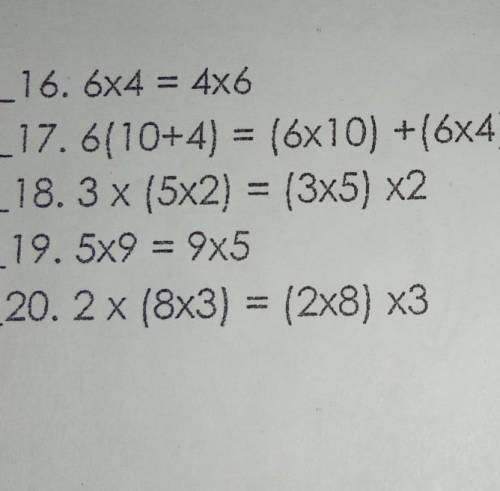
Mathematics, 05.03.2021 09:40 khannie
tukuyin ang properties at multiplication. is sulat ang cpm kung community property of multiplication, DPM kung distribute property of communication, at apm kung associative property of multiplication. 1. 6×4 = 4×6. 2. 6(10+4) +(6×10) +(6×4). 3. 3×(5×2)=(3×5)×2. 4. 5×9=9×5. 5. 2×(8×3)=(2×8)×3


Answers: 3


Other questions on the subject: Mathematics

Mathematics, 21.06.2019 16:50, fireman59937
Kapil needed to buy a long wooden beam. he went to two sawmills that each charge an initial fee plus an additional fee for each meter of wood. the following equation gives the price (in dollars) of a wooden beam from the first sawmill as a function of its length (in meters). p = 5+20xp=5+20x
Answers: 1

Mathematics, 21.06.2019 21:00, newsome1996p4ggft
5x−4≥12 or 12x+5≤−4 can you with this problem
Answers: 3

Mathematics, 21.06.2019 23:30, abell23000
Afriend of mine is giving a dinner party. his current wine supply includes 10 bottles of zinfandel, 8 of merlot, and 11 of cabernet (he only drinks red wine), all from different wineries. (a) if he wants to serve 3 bottles of zinfandel and serving order is important, how many ways are there to do this? ways (b) if 6 bottles of wine are to be randomly selected from the 29 for serving, how many ways are there to do this? ways (c) if 6 bottles are randomly selected, how many ways are there to obtain two bottles of each variety? ways (d) if 6 bottles are randomly selected, what is the probability that this results in two bottles of each variety being chosen? (round your answer to three decimal places.) (e) if 6 bottles are randomly selected, what is the probability that all of them are the same variety? (round your answer to three decimal places.)
Answers: 3

Mathematics, 22.06.2019 02:00, dollangellface22
The table below shows the approximate masses of a dust particle and a grain of pollen. dust particle 0.000000778 g grain of pollen 0.00000000155 g the mass of a dust particle can be estimated and written in the form a × 10^b, where a = 8 and b = the mass of a grain of pollen can be estimated and written in the form a × 10^b, where a = 2 and b = based on the estimates, the mass of a dust particle is approximately blank times larger than the mass of a grain of pollen.
Answers: 1
You know the right answer?
tukuyin ang properties at multiplication. is sulat ang cpm kung community property of multiplication...
Questions in other subjects:




English, 07.11.2019 20:31




Mathematics, 07.11.2019 20:31




